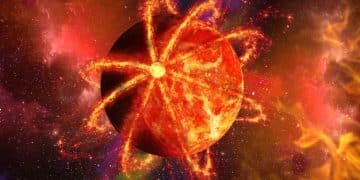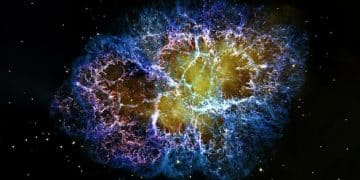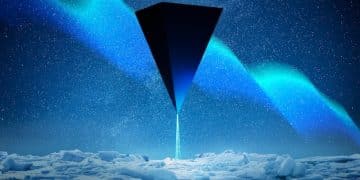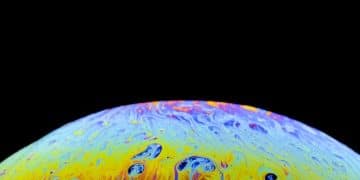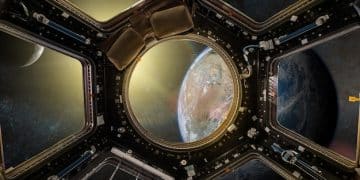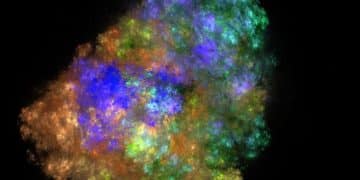Gravitational Waves: Unlocking Black Hole Secrets
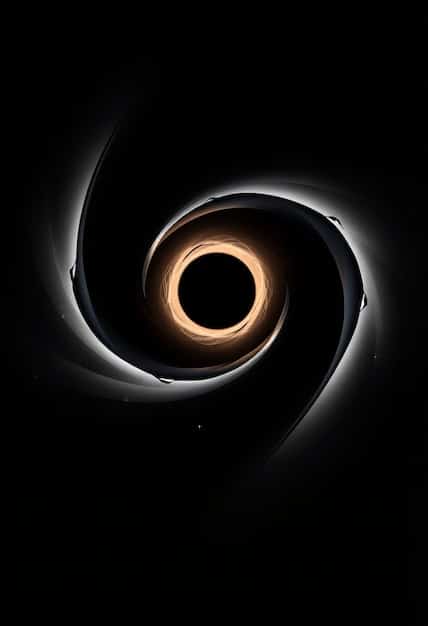
Gravitational waves, ripples in spacetime, provide unique insights into the mergers of black holes, revealing crucial information about their masses, spins, and the dynamics of these extreme cosmic events.
The detection of gravitational waves has revolutionized our understanding of the universe, particularly when it comes to black hole mergers. These cosmic events, once only theoretical, are now observable, providing unprecedented data about the nature of gravity and the evolution of black holes.
What are Gravitational Waves?
Gravitational waves are disturbances in the curvature of spacetime, generated by accelerated masses, that propagate as waves outward from their source at the speed of light. Predicted by Albert Einstein’s theory of general relativity, these waves carry information about the events that created them, offering astronomers a new way to observe some of the most energetic phenomena in the universe.
The Fabric of Spacetime
Imagine spacetime as a fabric, where massive objects create curves and distortions. When these objects accelerate, they create ripples in this fabric, similar to the waves created when you drop a pebble into a pond. These ripples are gravitational waves, carrying energy and information through the cosmos.
Detecting Gravitational Waves
Detecting these waves is an engineering marvel, requiring incredibly sensitive instruments like LIGO (Laser Interferometer Gravitational-Wave Observatory) and Virgo. These detectors use lasers to measure minuscule changes in distance caused by the passage of a gravitational wave.
- LIGO consists of two identical detectors located thousands of kilometers apart in Hanford, Washington, and Livingston, Louisiana.
- Virgo is a similar detector located in Italy, enhancing the network’s ability to pinpoint the sources of gravitational waves.
- The detection principle relies on measuring the interference pattern of laser beams traveling through long, perpendicular arms.
Gravitational waves provide a new window into the universe, allowing us to observe events previously invisible to traditional telescopes. This has opened up the field of multi-messenger astronomy, where data from gravitational waves are combined with electromagnetic observations to provide a more complete picture of cosmic events.
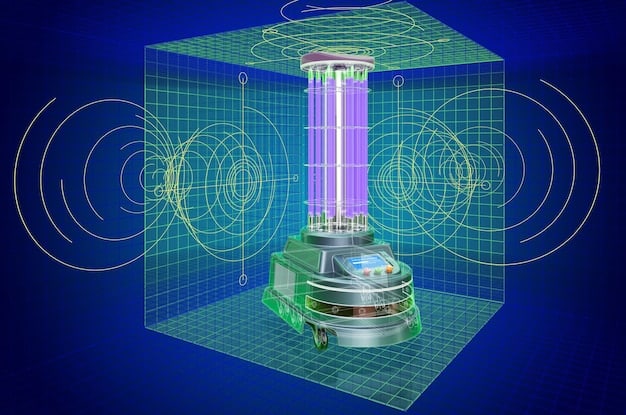
In summary, gravitational waves are ripples in spacetime that offer a unique way to study the universe. Their detection requires extremely sensitive instruments and provides valuable information about energetic events like black hole mergers, opening up new avenues for astronomical research.
Black Hole Mergers: A Cosmic Dance
Black hole mergers occur when two black holes, drawn together by gravity, spiral inward towards each other until they collide and form a single, larger black hole. These mergers are among the most violent events in the universe, releasing tremendous amounts of energy in the form of gravitational waves.
The Merger Process
The merger process can be divided into three main phases: inspiral, merger, and ringdown. During the inspiral phase, the black holes orbit each other, gradually getting closer while emitting gravitational waves. As they approach, their orbital speed increases until they collide in the merger phase. Finally, the newly formed black hole settles into a stable state during the ringdown phase, emitting a final burst of gravitational waves.
Information from Gravitational Waves
The gravitational waves emitted during a black hole merger carry crucial information about the properties of the black holes, such as their masses and spins. By analyzing these waves, scientists can determine the characteristics of the black holes involved and test the predictions of general relativity.
- Masses: The frequency and amplitude of the gravitational waves are directly related to the masses of the merging black holes.
- Spins: The way the black holes spin affects the waveform of the gravitational waves, allowing scientists to estimate their spin rates and orientations.
- Distance: The strength of the gravitational wave signal also indicates the distance of the merger from Earth.
Understanding black hole mergers is essential for understanding the evolution of galaxies and the formation of supermassive black holes at their centers. These mergers play a crucial role in shaping the structure of the universe.
Ultimately, the study of black hole mergers through gravitational waves offers invaluable insights into the nature of gravity and the life cycle of black holes, contributing significantly to our understanding of the cosmos.
Mass and Spin: Key Properties Revealed
The mass and spin of black holes are fundamental properties that dictate their behavior and influence the gravitational waves they produce during mergers. Analyzing these properties provides essential clues about the formation and evolution of black holes.
Determining Mass from Gravitational Waves
The mass of a black hole is directly related to the frequency and amplitude of the gravitational waves emitted during a merger. Higher mass black holes produce lower frequency waves with larger amplitudes, while lower mass black holes produce higher frequency waves with smaller amplitudes.
The Significance of Spin
The spin of a black hole, or its angular momentum, also plays a crucial role in the merger process. Spinning black holes can create more complex gravitational wave patterns, allowing scientists to probe the structure of spacetime around these objects.
How Spin Affects Waveforms
Black holes can spin either in the same direction as their orbit (aligned spins) or in a different direction (misaligned spins). The alignment of spins affects the waveform of the gravitational waves, providing insights into the dynamics of the merger.
- Aligned spins result in simpler, more predictable waveforms.
- Misaligned spins can cause the black holes to wobble or precess, creating more complex waveforms.
- Analyzing these waveforms allows scientists to determine the spin rates and orientations of the black holes.
By accurately measuring the masses and spins of black holes from the gravitational waves they emit, scientists can test the limits of general relativity and gain a deeper understanding of the cosmos.
In conclusion, the determination of mass and spin from gravitational waves offers pivotal information about black holes, contributing to our understanding of their behavior and the universe as a whole.
Testing Einstein’s Theory of General Relativity
The detection of gravitational waves has provided a unique opportunity to test Einstein’s theory of general relativity in extreme conditions. Black hole mergers, with their intense gravitational fields, offer the perfect laboratory to examine the predictions of this fundamental theory.
Predictions of General Relativity
General relativity predicts the existence of gravitational waves, their speed (the speed of light), and their behavior as they propagate through spacetime. By comparing the observed properties of gravitational waves with these predictions, scientists can verify the accuracy of general relativity.
Black Hole Mergers as Testing Grounds
Black hole mergers generate some of the strongest gravitational fields in the universe, providing an ideal environment to test the strong-field regime of general relativity. Any deviations from the predicted behavior could indicate new physics beyond our current understanding.
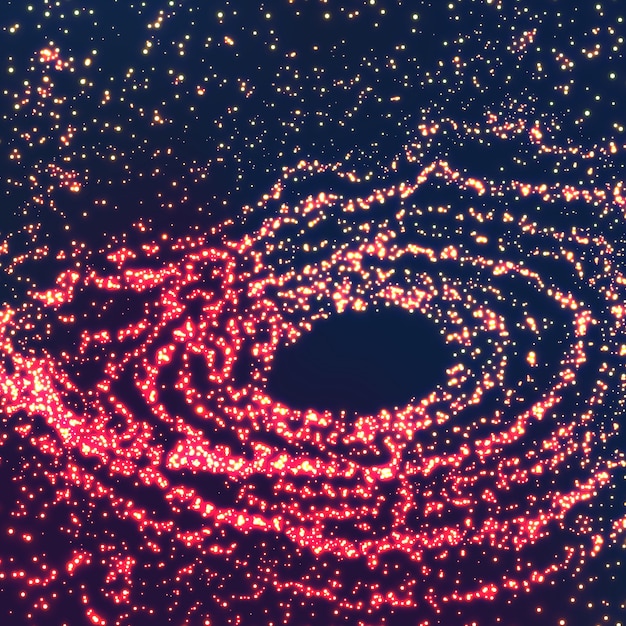
Analyzing Waveforms to Verify the Theory
Scientists analyze the waveforms of gravitational waves emitted during black hole mergers to identify any inconsistencies with the predictions of general relativity. This involves comparing the observed waveforms with theoretical models based on the equations of general relativity.
- Any discrepancies between the observed and predicted waveforms could indicate modifications to general relativity or the presence of exotic matter.
- So far, the observations have largely confirmed the predictions of general relativity, strengthening our confidence in this theory.
- Future observations with more sensitive detectors will provide even more stringent tests of general relativity.
Testing general relativity with gravitational waves is a cornerstone of modern astrophysics, and the results have profound implications for our understanding of gravity and the universe.
To summarize, the study of gravitational waves and black hole mergers strengthens our validation of Einstein’s Theory of General Relativity, reinforcing our understanding of gravity and the universe.
Multi-Messenger Astronomy: A New Era
Multi-messenger astronomy combines information from different types of signals, such as gravitational waves and electromagnetic radiation (light), to gain a more complete understanding of cosmic events. This approach provides a richer and more detailed picture than relying on a single type of messenger.
Combining Gravitational Waves and Light
While gravitational waves provide information about the dynamics of massive objects, electromagnetic radiation reveals details about their composition and environment. Combining these two types of information can provide a more holistic view of cosmic events.
The Potential of Multi-Messenger Observations
Multi-messenger observations have the potential to unlock new insights into the mysteries of the universe, from the formation of black holes to the origin of cosmic rays. By combining data from different sources, scientists can build more complete models of these phenomena.
Examples of Multi-Messenger Events
One notable example of a multi-messenger event is the detection of gravitational waves from a neutron star merger, accompanied by a burst of gamma rays and subsequent observations across the electromagnetic spectrum.
- The gravitational waves confirmed the merger of two neutron stars.
- The gamma-ray burst provided information about the ejection of material from the merger.
- Observations across the electromagnetic spectrum revealed the formation of heavy elements, such as gold and platinum, in the aftermath of the merger.
The era of multi-messenger astronomy has just begun. As more advanced detectors and telescopes come online, the potential of this approach will continue to grow, leading to groundbreaking discoveries about the universe.
In essence, multi-messenger astronomy enables a richer, more profound understanding of cosmic events by combining gravitational waves information with electromagnetic radiation, unlocking new mysteries of the universe.
Future Prospects and Advancements
The future of gravitational wave astronomy is bright, with plans for more sensitive detectors, expanded global networks, and new space-based observatories. These advancements will enable scientists to probe deeper into the universe and study a wider range of cosmic events.
Next-Generation Detectors
Next-generation detectors, such as Einstein Telescope and Cosmic Explorer, promise to be significantly more sensitive than current instruments. These detectors will be able to detect gravitational waves from more distant sources and with greater precision.
Expanding the Global Network
Expanding the global network of gravitational wave detectors will improve the ability to pinpoint the locations of sources in the sky. More detectors also increase the chances of detecting rare and unusual events.
Space-Based Observatories
Space-based observatories, such as LISA (Laser Interferometer Space Antenna), will be sensitive to lower frequency gravitational waves that cannot be detected from Earth. These waves are produced by supermassive black hole mergers, offering a unique window into the evolution of galaxies.
- LISA will consist of three spacecraft in a triangular configuration, orbiting the Sun millions of kilometers apart.
- The spacecraft will use lasers to measure tiny changes in distance caused by the passage of gravitational waves.
- LISA will be able to detect gravitational waves from supermassive black hole mergers billions of light-years away.
The future of gravitational wave astronomy promises to revolutionize our understanding of the universe, revealing new insights into the nature of gravity, black holes, and the cosmos.
In Summary, future prospects in gravitational wave astronomy look promising, aiming to revolutionize our perception of the universe.
| Key Point | Brief Description |
|---|---|
| 🌊 Gravitational Waves | Ripples in spacetime caused by accelerated masses, like merging black holes. |
| ⚫ Black Hole Mergers | The collision of two black holes, creating a single, larger black hole. |
| 🔬 Mass and Spin | Key properties of black holes that can be measured from gravitational waves. |
| 🔭 Multi-Messenger Astronomy | Combining gravitational wave data with other signals, like light, or others electromagnetic radiations . |
Frequently Asked Questions
▼
The primary instruments are laser interferometers like LIGO (in the US) and Virgo (in Italy). These detectors use lasers to measure tiny changes in distance caused by passing gravitational waves.
▼
Gravitational waves provide direct information about the mass, spin, and dynamics of black holes, especially during mergers. This allows scientists to test theories of gravity and probe the universe’s most extreme environments.
▼
Multi-messenger astronomy combines gravitational wave data with electromagnetic observations (like light, radio waves, etc.) to create a more comprehensive view of cosmic events. This provides a more complete picture than using a single messenger.
▼
Future advancements include more sensitive detectors like Einstein Telescope and Cosmic Explorer, an expanding global detector network, and space-based observatories like LISA, which will detect lower frequency gravitational waves.
▼
Black hole mergers provide insights into the formation and evolution of galaxies, the behavior of gravity under extreme conditions, and the origin of heavy elements, such as gold and platinum, when neutron stars are involved.
Conclusion
The detection of gravitational waves has opened a new window into the universe, particularly for studying black hole mergers. These events provide invaluable data about the properties of black holes, allow for stringent tests of general relativity, and pave the way for multi-messenger astronomy. As technology advances, the future of gravitational wave astronomy promises even more groundbreaking discoveries, deepening our understanding of the cosmos.
